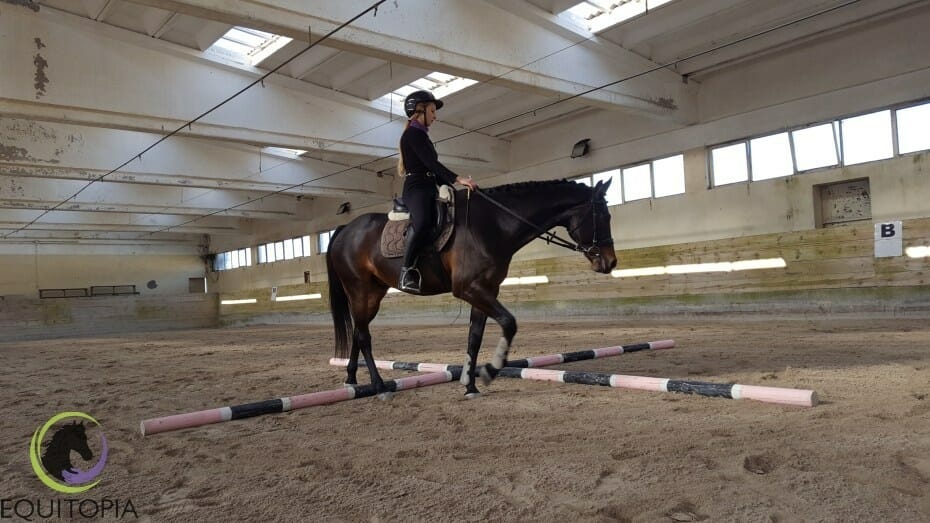
Exercises over ground poles (Photo courtesy of Hana Loverčič)
THE FOUNDATION FOR BUILDING A HAPPY AND HEALTHY ATHLETE BY ALJA KISILAK
Training horses is a very complex process, which can sometimes go quite smoothly and easily and sometimes it can represent quite a challenge. Early training has a big impact on the horse’s personality and some issues or challenges can play a part in the horse’s behaviour for the rest of his life. Therefore it is of the utmost importance to create good guidelines and stick to them, so we don’t get overwhelmed and lost in this long process. This is especially true nowadays when we have a vast choice of methods, approaches or equipment available.
START WITH A DETAILED GENERAL ASSESSMENT OF A HORSE
Before we start training or work with a new horse – either a young one or one in retraining or rehabilitation – an accurate physical and psychological assessment of the horse should be done. Observe the horse on the pasture, in the paddock, in the stable. Try to get information from his former owners or breeders. Scan and palpate every inch of his body, keeping an eye out for his natural asymmetry, crookedness, different hoof angles, scars and undeveloped, stiff or sensitive areas. Take a look at his conformation and his biomechanics in movement in all three (or more) gaits. Observe his reactions and attitude in different situations, especially when approaching other horses, humans or unknown objects. Try to define his personality and find out where his talents lie and what he enjoys doing.
All this information will help you make a successful, progressive and horse friendly training plan that sets the stage for a happy and healthy athlete that will be able to perform at his best for many years, enjoying his interaction with the human world.
Haflinger gelding learning Spanish walk at liberty (Photo above courtesy of Maja Yogev)
BASIC TRAINING AND PRIMARY SOCIALISATION
The horses that are meant to live in a modern human world, need to go through basic training to be properly socialised. The best scenario is one where this basic training and socialisation has happened when a horse was still a foal or a youngster. Primary socialisation can also be successful later on, but it will require more training skills, effort, patience and time. Basic training should consist of being accustomed to being approached by a human or another animal without panicking, being led on the halter and lead rope, being tied to a wall or fence, loaded on a transport vehicle, to pick up all four feet, being touched and brushed all over the body. At this stage, he should also start learning about the basics of yielding to pressure. This preparation of the horse sets the first layer of the base.
HORSE TRAINING PLAN – WE HAVE TO KNOW WHERE WE ARE GOING!
Having formed the initial assessment and taking into account our goals and wishes, it’s time to make a training plan. This should not be a rigid recipe, but a blueprint that will keep us on the right track. Sometimes it’s easy to lose the bigger picture when dealing with small challenges we encounter in the training process.
A good horse training plan should be:
-
- Set for each horse individually
-
- Progressive and systematic
-
- Made with room for improvisation, but is still predictable for the horse (same patterns, structure)
-
- Diverse (dressage training, cavalletti training, jumping gymnastics, hacking out, lunging, ground work, liberty training…)
-
- Develop the horse physically, emotionally and mentally
- Based on science, knowledge and intuitive feeling

A young horse searching for the vertical balance on the lunge line.
This post was written by Alja Kisilak. Alja is a riding instructor, passionate about bringing out the best in the horse and the rider and making the experience fun for both of them. In 2008 she graduated from the Biotechnical University of Ljubljana with a thesis on Equine Psychology. Her wide knowledge on the learning theory, coupled with strong intuition and feel enables her to combine the science and art of riding into a coherent whole. She is constantly on the lookout for new knowledge and experiences and this search has led her all over Europe, where she learned from some of the best trainers of classical dressage. In addition to her work with horses, she has a gift for working with people too. She worked as a main trainer, equine assisted psychotherapy facilitator and riding instructor at MKZ Rakitna, Grad Prestranek and Cavallista riding school. Her unique skill set enables her to understand the horse’s and the rider’s perspective and their individual needs, which is the perfect combination for training that is tailored to both horse and rider.





